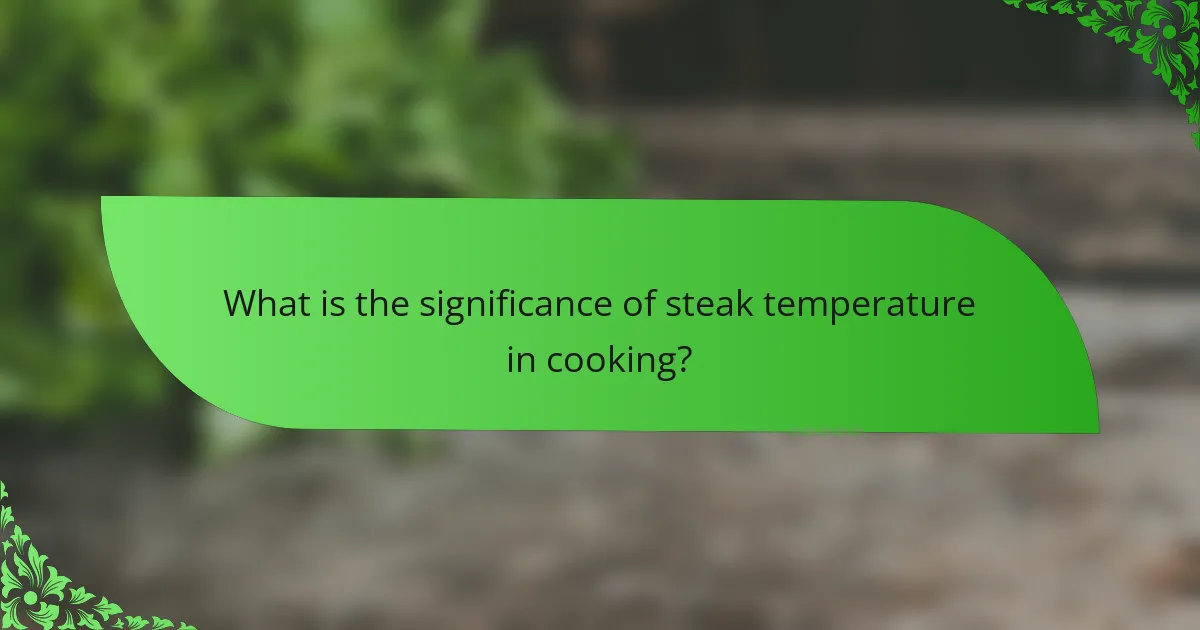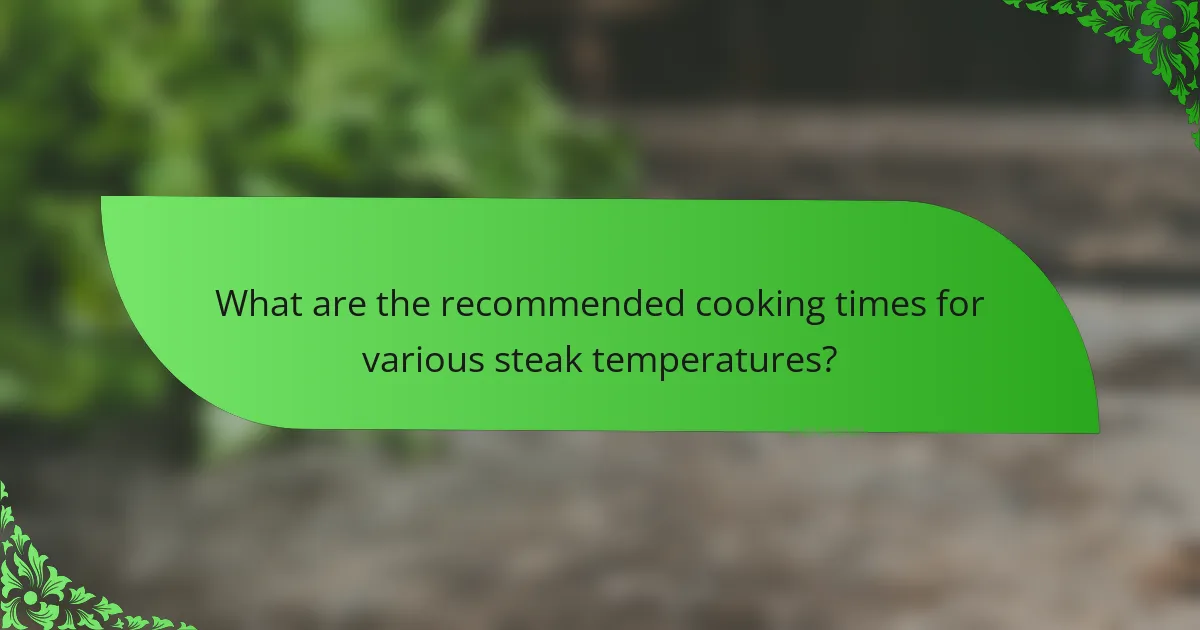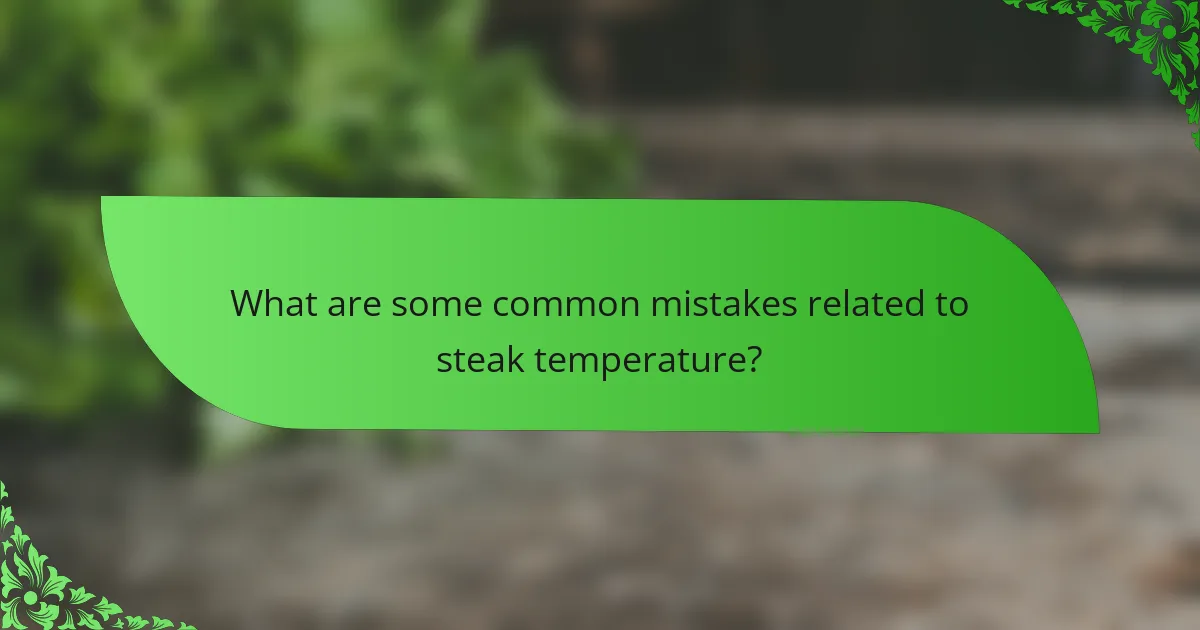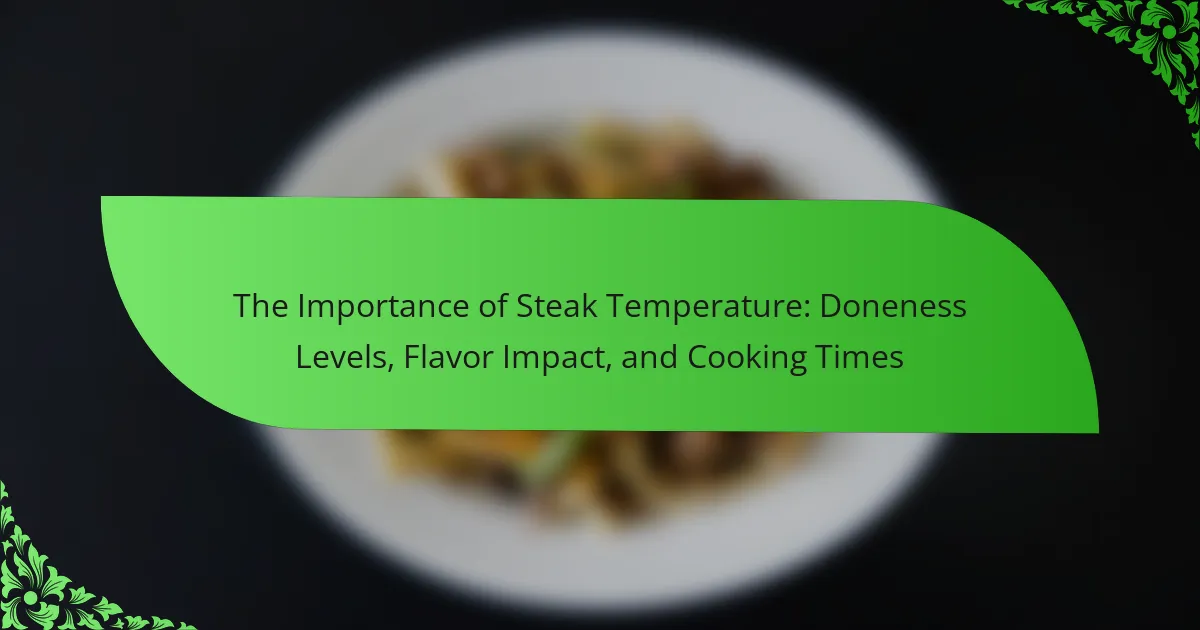Steak temperature is a critical factor in determining the doneness level of meat, significantly affecting its texture and flavor. Different internal temperatures correspond to varying doneness levels, such as rare at 125°F, medium-rare at 135°F, medium at 145°F, and well-done at 160°F or higher. This article highlights the recommended cooking times for each doneness level, emphasizing the importance of using a meat thermometer to avoid common mistakes that lead to overcooked or undercooked steak. Additionally, it discusses the Maillard reaction and its role in flavor development, along with the necessity of allowing steak to rest after cooking for optimal juiciness and enjoyment.

What is the significance of steak temperature in cooking?
Steak temperature is crucial in determining the doneness level of the meat. Different temperatures yield varying textures and flavors. For example, a rare steak is typically cooked to an internal temperature of 125°F, resulting in a soft and juicy texture. Medium-rare, at 135°F, enhances the meat’s flavor while maintaining moisture. Medium doneness occurs at 145°F, providing a firmer texture with less juiciness. Cooking steak to 160°F or higher results in a well-done steak, which can become tough and dry. The Maillard reaction, which occurs at higher temperatures, contributes to the flavor development during cooking. Properly monitoring steak temperature ensures optimal taste and texture, enhancing the overall dining experience.
How does steak temperature affect its doneness levels?
Steak temperature directly determines its doneness levels. The internal temperature of steak correlates with specific doneness classifications. For example, rare steak is typically cooked to an internal temperature of 120-125°F. Medium-rare steak reaches 130-135°F, while medium steak is cooked to 140-145°F. Medium-well steak is at 150-155°F, and well-done steak exceeds 160°F. Each temperature range affects the texture and juiciness of the steak. Higher temperatures result in more moisture loss, leading to a firmer texture. According to the USDA, proper cooking temperatures ensure food safety and enhance flavor profiles.
What are the different doneness levels for steak?
The different doneness levels for steak are rare, medium-rare, medium, medium-well, and well-done. Rare steak has a cool, red center, typically cooked to an internal temperature of 120-125°F. Medium-rare steak features a warm, red center and is cooked to 130-135°F. Medium steak has a pink center and is cooked to 140-145°F. Medium-well steak is mostly brown with a hint of pink and is cooked to 150-155°F. Well-done steak is fully cooked through with no pink, reaching an internal temperature of 160°F or higher. These doneness levels significantly affect the flavor and texture of the steak.
How can you accurately determine the doneness of steak?
To accurately determine the doneness of steak, use a meat thermometer. Insert the thermometer into the thickest part of the steak, avoiding bone and fat. For rare steak, the internal temperature should be 120-125°F. Medium-rare steak should reach 130-135°F. Medium steak is done at 140-145°F. For medium-well, the temperature should be 150-155°F. Well-done steak reaches an internal temperature of 160°F or higher. Using a thermometer provides precise readings, ensuring the steak is cooked to your preference. This method is recommended by the USDA for food safety and quality.
Why is understanding steak temperature important for flavor?
Understanding steak temperature is crucial for maximizing flavor. Different temperatures affect the meat’s juiciness and tenderness. For instance, a medium-rare steak, cooked to about 130-135°F, retains optimal moisture and flavor compounds. At this temperature, the proteins are tender, and the fat is just beginning to melt, enhancing the steak’s richness. Conversely, cooking steak beyond medium can lead to dryness and a tougher texture. Research shows that overcooking can diminish flavor by breaking down essential amino acids and fats. Therefore, mastering steak temperature directly influences the overall taste experience.
How does cooking steak at different temperatures impact flavor profiles?
Cooking steak at different temperatures significantly affects its flavor profiles. Higher temperatures create a Maillard reaction, enhancing the savory, umami flavors. This reaction occurs between 300°F to 500°F, producing a crust that adds complexity. Conversely, cooking at lower temperatures retains more moisture and tenderness. This method often results in a milder flavor profile.
Steaks cooked rare (120°F to 125°F) have a soft texture and a pronounced beefy flavor. Medium-rare (130°F to 135°F) offers a balance of tenderness and flavor depth. Medium (140°F to 145°F) introduces a firmer texture with reduced juiciness. Well-done steaks (160°F and above) lose moisture and can become tough, leading to a less flavorful experience.
Studies indicate that the temperature directly correlates with the release of flavor compounds. For instance, research shows that the breakdown of fats and proteins at higher temperatures enhances flavor intensity.
What role does the Maillard reaction play in flavor development?
The Maillard reaction is crucial in flavor development during cooking. It occurs when amino acids and reducing sugars react under heat. This reaction creates complex flavor compounds and browning on the surface of food. For example, the rich flavors in seared steak result from this process. Studies show that the Maillard reaction significantly enhances the taste and aroma of cooked meats. The reaction begins at temperatures around 285°F (140°C). Higher temperatures accelerate flavor development through more intense reactions. This is why achieving the right steak temperature is essential for optimal flavor.

What are the recommended cooking times for various steak temperatures?
The recommended cooking times for various steak temperatures vary based on the desired doneness. For rare steak, cook for about 120-130°F for 2-3 minutes per side. For medium-rare, aim for 130-135°F, cooking for 3-4 minutes per side. Medium steak requires a temperature of 135-145°F, with cooking times of 4-5 minutes per side. For medium-well, the target is 145-155°F, cooking for 5-6 minutes per side. Well-done steak should reach 160°F and requires about 6-7 minutes per side. These times can vary based on steak thickness and cooking method.
How do cooking methods influence steak temperature and doneness?
Cooking methods significantly influence steak temperature and doneness levels. Different techniques, such as grilling, pan-searing, and sous-vide, affect heat transfer. Grilling exposes steak to direct flames, resulting in a quick sear and varying internal temperatures. Pan-searing creates a crust while allowing for controlled cooking, impacting doneness. Sous-vide offers precise temperature control, ensuring even doneness throughout.
Research shows that cooking steak at high temperatures can lead to a Maillard reaction, enhancing flavor but potentially overcooking the interior. For instance, a grill’s high heat can achieve medium-rare doneness at around 130-135°F in less time than slow cooking methods. Overall, the choice of cooking method directly correlates with the final steak temperature and desired doneness.
What are the best cooking techniques for achieving desired doneness?
The best cooking techniques for achieving desired doneness include grilling, pan-searing, and sous vide. Grilling allows for high heat and direct contact, creating a flavorful crust while cooking the interior to the desired temperature. Pan-searing provides a similar benefit, allowing for a quick sear on the outside while retaining moisture inside. Sous vide cooking offers precise temperature control, ensuring even cooking throughout the steak.
Using a meat thermometer is essential for accurately measuring doneness. For example, medium-rare steak should reach an internal temperature of 130-135°F. Each technique has its strengths, but the key is to monitor the temperature closely to achieve the perfect doneness.
How does the thickness of the steak affect cooking times?
The thickness of the steak significantly affects cooking times. Thicker steaks require longer cooking times to reach the desired internal temperature. For example, a 1-inch steak typically takes about 10-12 minutes to cook to medium-rare. In contrast, a 2-inch steak may take 20-25 minutes for the same doneness level. This is due to the heat penetrating more slowly through thicker cuts. Additionally, thicker steaks can better retain moisture, impacting the overall cooking process. Cooking methods and temperatures also play a role in how thickness influences time. Using a meat thermometer can ensure accuracy in achieving the desired doneness level.
What tools can help ensure accurate steak temperature measurement?
Thermometers are essential tools for accurate steak temperature measurement. Instant-read thermometers provide quick readings, ensuring precision in cooking. Probe thermometers can remain in the steak during cooking, allowing continuous monitoring. Infrared thermometers measure surface temperature without contact, offering speed and convenience. Each of these tools helps achieve the desired doneness, enhancing flavor and texture. Accurate temperature measurement is crucial for food safety and optimal cooking results.
What types of thermometers are best for measuring steak temperature?
Instant-read thermometers and probe thermometers are best for measuring steak temperature. Instant-read thermometers provide quick readings, usually within 2-3 seconds. They are ideal for checking doneness without leaving the steak on the grill for too long. Probe thermometers can remain in the steak while it cooks. This allows for continuous monitoring of the temperature. Both types ensure accurate readings, which is crucial for achieving the desired doneness. According to the USDA, the safe minimum internal temperature for steak is 145°F. Using these thermometers helps prevent undercooking or overcooking.
How can you use visual cues alongside temperature for perfect steak?
To achieve perfect steak, use visual cues alongside temperature readings. Look for color changes in the meat’s surface. A rare steak has a bright red center, while medium-rare shows a warm pink. Medium steak appears light pink, and well-done is uniformly brown.
Check the juices; clear juices indicate doneness, while red or pink juices suggest further cooking is needed. Additionally, the steak’s firmness provides feedback. A rare steak feels soft, while a well-done steak is firm to the touch.
Use a meat thermometer for accurate internal temperature. Aim for 125°F for rare, 135°F for medium-rare, 145°F for medium, and 160°F for well-done. Combining visual cues with these temperature benchmarks ensures a perfectly cooked steak.

What are some common mistakes related to steak temperature?
Common mistakes related to steak temperature include not using a meat thermometer, cooking at the wrong heat level, and misunderstanding doneness levels. Many cooks rely on visual cues instead of accurate measurements. This can lead to overcooked or undercooked steak. Cooking at a too high heat can char the outside while leaving the inside raw. Conversely, cooking at too low a temperature may result in a lack of flavor and texture. Misunderstanding doneness levels can cause confusion. For instance, medium-rare steak should reach an internal temperature of 130-135°F. Not allowing the steak to rest after cooking can also lead to loss of juices. These mistakes affect the overall quality and enjoyment of the steak.
Why do some cooks struggle with achieving the right steak doneness?
Some cooks struggle with achieving the right steak doneness due to a lack of experience and understanding of cooking techniques. Many novice cooks rely on visual cues rather than precise temperature measurements. The ideal doneness is achieved at specific internal temperatures, such as 130°F for medium-rare. Inconsistent heat sources can also affect cooking times and outcomes. Additionally, factors like steak thickness and cut can influence doneness. According to the USDA, a lack of knowledge about resting time can lead to overcooked steak. Understanding these variables is crucial for consistent results.
What are the consequences of overcooking or undercooking steak?
Overcooking steak leads to a tough and dry texture. The high heat breaks down proteins excessively, removing moisture. This results in a less enjoyable eating experience. Undercooking steak can pose food safety risks. It may harbor harmful bacteria like E. coli or Salmonella. Proper cooking temperatures are essential to eliminate these pathogens. The USDA recommends a minimum internal temperature of 145°F for safety. Additionally, undercooked steak may have an unpleasant chewy texture. Both overcooking and undercooking negatively impact flavor and tenderness.
How can resting steak improve final doneness and flavor?
Resting steak improves final doneness and flavor by allowing the juices to redistribute throughout the meat. When steak cooks, the juices move toward the center due to heat. Resting for 5 to 10 minutes helps these juices settle back into the meat. This process enhances moisture retention, resulting in a juicier steak. Additionally, resting allows the internal temperature to rise slightly, achieving the desired doneness. Research indicates that resting can increase tenderness and overall flavor profile. The USDA recommends resting meat to enhance both taste and texture.
What are the best practices for cooking steak to the perfect temperature?
To cook steak to the perfect temperature, use a meat thermometer for accuracy. The ideal internal temperatures vary by doneness: 130°F for medium-rare, 140°F for medium, and 160°F for well-done. Start by bringing the steak to room temperature before cooking. This helps it cook evenly. Sear the steak on high heat for a crust, then reduce heat to finish cooking. Let the steak rest for five to ten minutes after cooking. This allows juices to redistribute, enhancing flavor. Following these practices ensures a perfectly cooked steak every time.
What tips can help ensure consistent results in steak cooking?
To ensure consistent results in steak cooking, start with selecting the right cut of meat. Choose steaks with even marbling, as this enhances flavor and tenderness. Use a meat thermometer to check internal temperature accurately. For medium-rare, aim for 135°F (57°C). Let the steak rest for at least five minutes after cooking. This allows juices to redistribute, improving flavor and moisture. Preheat the grill or pan to high heat before cooking. This creates a proper sear, enhancing texture. Flip the steak only once during cooking for even browning. Following these tips leads to reliably delicious steaks.
How can you troubleshoot common issues with steak doneness?
To troubleshoot common issues with steak doneness, check the internal temperature with a meat thermometer. For rare steak, aim for 120-125°F. For medium-rare, target 130-135°F. For medium, look for 140-145°F. For medium-well, ensure it reaches 150-155°F. Lastly, for well-done, the temperature should be 160°F or higher. If the steak is undercooked, return it to the heat until it reaches the desired temperature. If overcooked, consider slicing it thinly or using it in a stew to salvage the meat. Consistent monitoring of cooking times and temperatures helps prevent doneness issues.
The main entity of this article is steak temperature, which plays a critical role in determining the doneness levels, flavor profiles, and cooking times of steak. The article outlines the various doneness levels, including rare, medium-rare, medium, medium-well, and well-done, detailing their corresponding internal temperatures and how these affect texture and juiciness. It also emphasizes the importance of using a meat thermometer for accurate temperature measurement and discusses the impact of cooking methods and steak thickness on achieving desired doneness. Additionally, the article addresses common mistakes in cooking steak and provides best practices for ensuring optimal flavor and tenderness.
